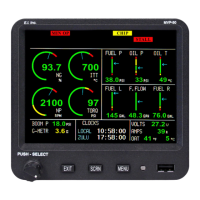c) Action: The Tach Gen. can be removed from the engine and spun with a drill (be sure the Tach
Gen is grounded to the same ground as the EDC. You should see a reading around 10 to 20%.
Normally, 4200 RPM = 100% reading.
2. Problem: Wrong calibration data.
a) Action: Check the calibration numbers on the "Engine Data, Hour Meters and Flight Timer
Setup" screen.
7.6 Fuel Flow Problem:
Fuel Flow is measured using a Flow Transducer. Power (+10 volts on the Red wire) and ground (Black wire) is
supplied to the transducer from the EDC. A rotor in the transducer spins and produces pulses (0 to +5 volts) on the
White wire. The +5 volts portion of the pulse on the White wire comes from a pull-up resistor in the EDC. The
K-factor found in the “Add Fuel” screen calibrates the pulses to a flow rate.
A. Symptom: Inaccurate readings.
1. Problem: The K-factor is incorrect.
a) Action: Check that the K-factor (found in the “Add Fuel” screen) is correct for the transducer
installed in the aircraft (FT-60 red cube = 68,000, FT-90 gold cube = 33,800 and the FT-180 black
cube = 22,400).
B. Symptom: Inaccurate, jumpy or zero reading.
1. Problem: A wire is open, shorted or mis-wired.
a) Action: Measure the voltage on the transducer wires from the EDC at the Flow Transducer. The
Red lead = +10 volts, Black wire = 0 volts, White wire = + 5 volts with the White wire removed
from the ow transducer.
Ohm the Black wire to ground. The Black wire must be shorted to ground (< 10 ohms).
Rapidly tap the White transducer wire to ground. A small fuel ow reading should show on the
MVP.
2. Problem: The rotor in the Fuel Flow Transducer is blocked.
a) Action: Remove the Flow Transducer from the aircraft. Lightly blow into the transducer and
check for the rotor to spin freely. Check for a Fuel Flow reading on the MVP when the rotor is
spinning.
If the rotor in the Flow Transducer does not spin, hold the transducer over white paper and tap at all
angles. Debris can lodge in the transducer and block the rotor.
7.7 Amp Problem:
Amps are measured on the aircraft using a Shunt. A Shunt has very low resistance and produces a differential voltage
on the two signal wires connected to the Shunt. The differential voltage is proportional to the amperage flowing
through the Shunt (50 mV at 50 Amps for the S-50 Shunt). In series with the two signal wires are two fuses to protect
56

